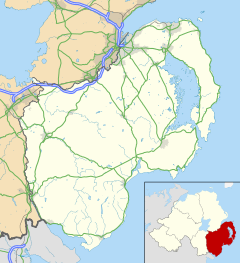Dundonald
| Dundonald | |
|---|---|
 Dundonald Moat and St Elizabeth's Church |
|
| Dundonald shown within County Down | |
| Population | 16,098 (2011 Census) |
| District | |
| County | |
| Country | Northern Ireland |
| Sovereign state | United Kingdom |
| Post town | BELFAST |
| Postcode district | BT16 |
| Dialling code | 028 |
| EU Parliament | Northern Ireland |
| UK Parliament | |
| NI Assembly | |
Dundonald (from Irish: Dún Dónaill, meaning "Dónall's stronghold") is a large settlement and civil parish in County Down. It lies east of Belfast and is often deemed to be a suburb of the city. It includes the large housing estate of Ballybeen, and many new housing developments have emerged in the past ten years.
Dundonald refers to a 12th-century Norman fort, or Dún, Dún Dónaill, that stood in the town. One of the largest in Ireland, the man-made hill that the fort stood on is still in existence.
Although the mound is commonly referred to as 'the moat' this is, in fact, a corruption of the word 'motte' and refers to the fact that this defensive structure was built in the style of a motte and bailey. St. Elizabeth's Church is located beside the moat, with the Cleland Mausoleum in the adjacent graveyard.
Dundonald acquired rail links to Belfast and Newtownards in 1850, Downpatrick in 1859 and Newcastle in 1869. The town was located on the once extensive Belfast and County Down Railway mainline. The rail link with Belfast encouraged Dundonald to expand as a commuter town, but in 1950 the railway line running through Dundonald was closed. Dundonald railway station was opened on 6 May 1850, but finally closed on 24 April 1950. In the 1960s, Dundonald was deemed a small village. A number of property developments, most notably the housing estate Ballybeen, were then built and Dundonald's population rapidly grew.
For census purposes, Dundonald is not treated as a separate entity by the NI Statistics and Research Agency (NISRA). Instead, it is combined with a large part of east and southeast Belfast to form the "Castlereagh Urban Area". A fairly accurate population count can be found by combining the data of the electoral wards that make up Dundonald. These wards are Ballyhanwood 1, Carrowreagh, Dundonald, Enler, and Grahams Bridge. However, the wards also include part of the countryside surrounding Dundonald.
...
Wikipedia

